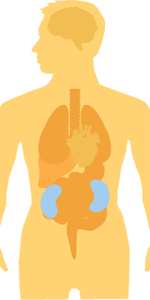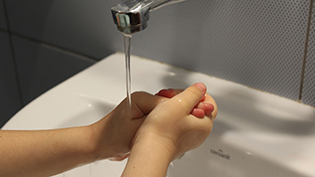Water For Life
People can’t live without water - we need it to drink, to cook with and to wash ourselves. 
The average person in the UK uses 165 litres of water a day. This takes into account cooking, cleaning, washing and flushing.
The human body is made up of two thirds water and without water we would die.
A person could live for weeks without food but only about one week without water.
Every living plant or animal needs water to live and grow.
Our Bodies and Water
We all know that water is good for us but a lot of people don't know that not drinking enough water can cause problems such as:
- Dizziness
- Headaches
- Kidney problems
- Constipation
- Dehydration (lack of water)
Water is the only drink that contains absolutely no calories or fat. Drinking lots of water can help:
- give you healthy skin
- boost your energy levels
- keep you mentally alert

- keep you, your bones, teeth, hair and nails healthy
- Our bodies need water to:
- Clean the blood passing through the kidneys.
- Keep body temperatures even.
- Help digest food.
- Carry food and oxygen to body parts/organs.
- Prevent salt from building up in the body.
- Remove waste products from food and drink.
- Help remove carbon dioxide from our muscles.
Water is an important ingredient of human tissue and cells. It fills hollows between your bones, and flows through kilometres of arteries and veins along with your blood.
The body also needs water to clean the blood in the kidneys. All the blood passes through the kidneys 15 times a day where water helps to 'wash' it. If the kidneys fail, the human body cannot survive for more than 3 weeks with unclean blood.
Are You Drinking Enough Water?
The colour of your wee may indicate that you are dehydrated. This means that the amount of fluids (water) your body is losing is more than the amount of water your body is taking in.
The Food Standards Agency advise that we take around 1.5 to 2 litres of water in a typical day. That’s the same as 6 to 8 250ml glasses.
Water for Hygiene

You have between 10,000 and 10 million bacteria on each hand.illustration of person washing their hands. The number of germs on your fingertips doubles after you use the toilet.
Only about 70% of people wash their hands after being to the toilet.
Regular hand washing is a good way of stopping the spread of disease by direct or indirect contact. In public toilets, liquid soap and either paper towels or hot air dryers are best. Using these properly and regularly will remove most germs.
Examples of when we should wash our hands:
- Before eating food.
- Before preparing any food.
- After using the toilet.
- After contact with blood, vomit or other body fluids.
- After handling pets, pet cages or anything pets have touched.
- After going out to play
- After coming into contact with anything dirty, like rubbish bins
Washing with soap and water will only work if it is done properly. We need to wash the backs and fronts of our hands, and the tips and sides of our fingers. Use a blob of soap and plenty of warm water to sluice it off.
Washing your hands properly takes about as long as singing ‘Happy Birthday’ twice.
Find out how to wash your hand properly by downloading our Clean Hands Poster





